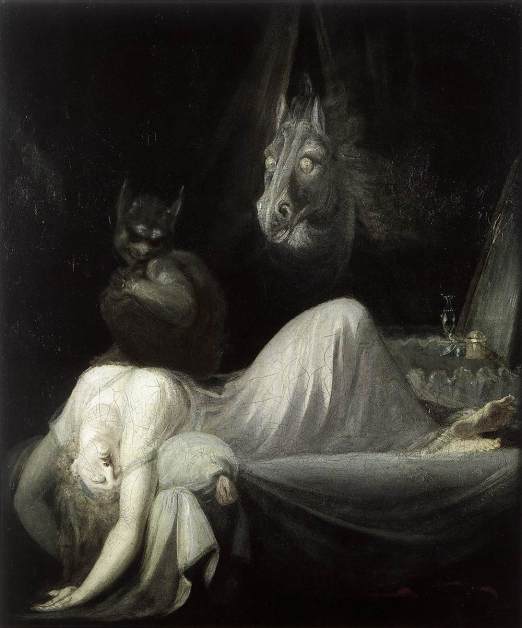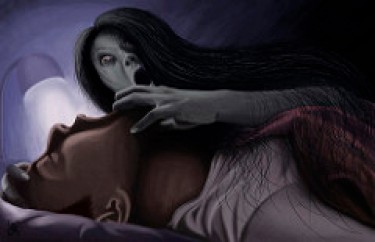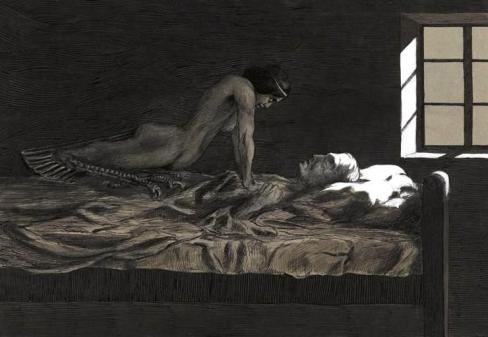I love sleep. I love learning about sleep cycles, the sleeping habits of famous artists, my own bedtimes, and, of course, dreams. My obsession has leaked out a little in this blog: last year we talked a little about the Shadow People, dark figures who show up in people’s bedrooms (among other places) when they’re not quite asleep, yet not quite awake. This year we took on the Popobawa, a Zanzibarian incubus that was real enough to his community that he caused real damage. Really, I figured I probably hold off on the sleep-related terrors for a while. But then I happened upon this article entitled “Can You Really Die in Your Nightmares?”, and…well, this is the result.
First, let’s look closely at the phenomenon of sleep paralysis. For those of you unfamiliar with the term, sleep paralysis is something that is, arguably, even worse than your worst normal nightmare (“nightmare” meaning frightening dream). The scientific explanation for how sleep paralysis happens goes like this:
- There are a number of different sleep cycles we go through each night, from tiny wakening periods to light sleep to deep sleep to REM sleep. In REM—that most famous of sleep cycles–our heartbeat increases, our breathing becomes more shallow, our eyes dart back and forth behind closed lids, and we start to dream.
- To avoid us acting our dreams of being chased, stabbing zombies, or doing the polka with Captain Hook, our bodies shut down during REM sleep, essentially putting us in a state of temporary paralysis. As we exit REM, the paralysis releases, and we get up, rub our eyes, and try in vain to recall what in the hell just happened. At least, that’s how it normally goes.
- But sometimes things go wrong. The body gets out of sync, and we wake up (or think we’re awake), but the paralysis is still gripping us tight and we can’t move or cry out. Right around then is when we start to see things. Hear things. Feel things.

A famous depiction of sleep paralysis/night-mare/terrible time, courtesy of Wikimedia Commons.
Remnants of dreams, surely. That’s what Western science would have us believe. But if those are remnants of dreams, they are scary as f***. Because the thing with sleep paralysis—and the things we see therein—is that it feels very much like we are awake. We perceive our room as it really is, we’re aware that we’re in bed and have just woken up, so it can be very disconcerting to know all this and then realize that there’s something standing your bedroom corner.
I’ve talked before about how I woke up one night to see a tall figure lurch at me from out of my closet—such a vivid experience that I remember it perfectly almost two decades later. But other people with sleep paralysis have had it worse. It’s common to not only see and/or sense a figure, but to have it on top of you, too feel its weight, and have the air crushed out of your chest. All this, and you can’t scream—can’t even move. The experience can last for several minutes, and can be so horrific that language can’t express it.
A lot of my research for this post came from looking through reviews (and reading sections of) a book called Night-mares, Nocebos, and the Mind Body Connection by Dr. Shelley Adler, director of the Osher Center for Integrated Medicine at the University of California, San Francisco. In what I’ve read of her book,* Adler points out that while 25-30% of people will experience an episode of sleep paralysis (what she calls a “night-mare”, hearkening back to the original meaning of the word) sometime in their life, in the U.S. the phenomenon is “simultaneously very common and little known.” This might be because, as she explains, our culture enforces a strict dichotomy between what we consider “real” (“visible, measurable, evidence-based”) and “unreal” (“supernatural, religious, unprovable”). We take that “real” and “unreal” things are non-compatible for granted, but that’s something our culture has created for us—the rest of humanity doesn’t necessarily agree.
Nor should they, according to Adler. It is foolhardy to assume that just because we do not currently have the tools to “prove” that something exists must mean that that something does not exist. Also, things that are “not real” can have very real effects.

A more modern depiction of the joys of sleep paralysis, courtesy of Gerard Van Der Leun on Flickr.
Across the U.S. in the late 1970’s and early 1980’s, almost 200 people—mostly young, healthy men at an average of 33 years of age—abruptly died in their sleep. Some were said to cry out in the night. Others just went cold. Their spouses and families were stricken; their communities terrified. All of the men were Laotian-Hmong refugees who had recently come to the U.S., but besides that shared little in common. In whispers, they named the phenomenon the Night Terror; people became afraid to go to bed.
The refugees’ families often refused autopsies for religious reasons, but the few that did found no pathological evidence to explain why they died. A few showed slightly enlarged hearts, as if they had just…“shorted out.”
It’s easy to fill in the blanks with your imagination, knowing what we do about how intense little sleep-visitations can be. Adler claims that Laotian beliefs about demons, combined with the stress of being a refugee, might have exacerbated whatever genetic heart problems these men might have had and made their night-mares not just frightening, but deadly. That alone is bananas. But it’s not just Laotians that have died.
Check out this article from the American Journey of Forensic Medicine and Pathology, wherein data collected between 2001 and 2006 in Southern China revealed a whopping 975 cases of SUNDS—Sudden Unexpected Nocturnal Death Syndrome, what scientists call this mystery death in your sleep. It, too, explores the idea that SUNDS might be associated with funky stuff going on in REM sleep, and the breathing and heart abnormalities that might result. Funky stuff like things being out of sync. Like what happens in sleep paralysis—Adler’s night-mares.
Genetics, again, could play a part, as could stress, socioeconomic background, and being overworked. But that doesn’t change the fact that these SUNDS victims might have faced down something terrible in the dead of night, and that thing could have been the last thing they saw.
We humans face a lot of stressful, frightening things in ordinary life. Their pedestrian nature can be exactly what makes them so scary. So let me offer you the comfort of this supernatural horror, to help you keep things in perspective: in the end, it may not matter whether that monster in your closet is “real” or a leftover dream. He can still kill you.

A nice closing image to leave you with, courtesy of Fritz Schwimbeck at Wikimedia Commons.
Have you ever had an unfriendly night time visitor? One time, while camping, I woke up to find a raccoon standing on my sleeping bag. Share your thoughts on that in the comments below.
* Sadly, I haven’t had a chance to read though all of it yet thanks to moving last weekend and an exceptionally heavy workload at my day job. Apologies to Dr. Adler and everyone else.
WANT TO SEE MORE OF GERARD VAN DER LEUN? FIND HIM HERE. Featured image by John Soo.





I enjoyed reading this. Hoping to wake up dead next to you some day! Please feed my body to Robin.
❤️❤️♥️
Jess, I’ve had a couple of experiences of this and have talked with several who I have had a variety of similar experiences. Some college friends of mine were doing missions work in Eastern Europe back before the iron curtain fell and were all sleeping together in on apartment when they all woke up suddenly sensing something evil and discovered one of the guys was being strangled by invisible hands around his throat. After a few panicked moments they prayed and it stopped it. I recently was invited to a recovery unit to pray with someone who was repeatedly having these kinds of events: hair pulling, bed shaking, pressure, intimate touching, etc. All with no one near her. It’s my belief that this stuff is demonic. I chatted with the woman for awhile and not only prayed but encouraged her to pray very simply when things happened. I’m happy to say that after a few more similar events the woman pressed through with prayers and the events stopped. It was a big deal because she was so scared she was going to leave the inpatient facility where she was getting help. I also met some folks who were missionaries in Nepal who have quite a story but I won’t take the time to relate it here!
That’s crazy! Yeah, it can be seriously disturbing stuff. I’m glad I’ve only experienced it that one time.